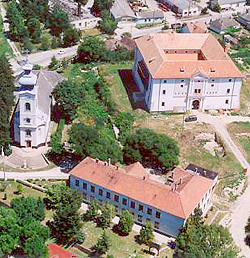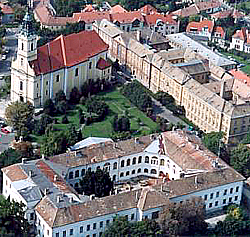|
The hilly county in the south is popular with nature lovers and hunters: here you can find the world-famous forest of Gemenc, where you can often see big game, as well. More and more applied folk artists - potters, wood carvers or blue dyers - work in the region. The Vintage Festival of Szekszárd also attracts many visitors. The wines of Szekszárd such as the full-bodied kékfrankos and merlot with a harmonious, rich bouquet have a long history. According to the legend, Schubert was also inspired by the red wine of Szekszárd when composing his famous piano quintet "The Trout".
The castle of Pipo of Ozora can be found in the village bearing the same name. In the Gothic castle with a regular square foundation the Gyula Illyés Memorial Museum was established. The writer-poet was born and brought up in Rácegrespuszta nearby. In Szekszárd, in the Mihály Babits Memorial Museum you can see the family documents of the poet as well as portraits of Babits by Pál Farkas, József Rippl-Rónai, Oszkár Glatz and Ö. Fülöp Beck. The territory was inhabited as early as the migration period. Near Szekszárd a burial place of Avars making ceramics was found by archaeologists, but Celtic and Roman relics were also found in the territory. Pottery, which is still popular in the region, can date back to this ancient period. In Bátaszék the ruins of the first Cistercian abbey founded by King Géza II can be seen in the garden of ruins. The castle of Dombóvár is also called Gólyavár (castle of storks) as storks settled down on the remains of its mediaeval walls. The only preserved Serbian Orthodox monastery church of Hungary was built in baroque style, the monastery next to it used to be the intellectual and religious centre of the Serbians of the whole Carpathian basin. The Gothic castle of Dunaföldvár, the so-called Csonka-torony (broken tower) served as a prison for a long time. In the course of restoration a "highwayman's fresco" was found on its wall presenting the story of a captured man condemned to death. The castle of Simontornya reflects the features of all the important periods including Gothic, Renaissance and baroque elements.
The neoclassical building of the old county hall in Szekszárd was built according to plans by Mihály Pollack. In the courtyard you can see the ruins of a Benedictine abbey, as well as a baroque coat-of-arms made of stone. A unique attraction is the row of bazaars in Paks built in romantic style in the period of the Compromise of 1867. The Museum of Honey-cake-, Candle- and Sweets Making in Szekszárd is a real attraction providing Honey-sweet Memories to visitors. The "exhibits" can be purchased on the premises. The exhibition presents the secrets of honey-cake making and the different methods of making sweets and bee-wax candles. Lodgings in Tolna county: Sights in Tolna county: |
Tolna county map nagyítása >>
in Tolna county:
|
|
|
Hungary - Tolna county |
|
|
|
||
|
Saturday, 20. December 2025. - 00:18:40 |
||


